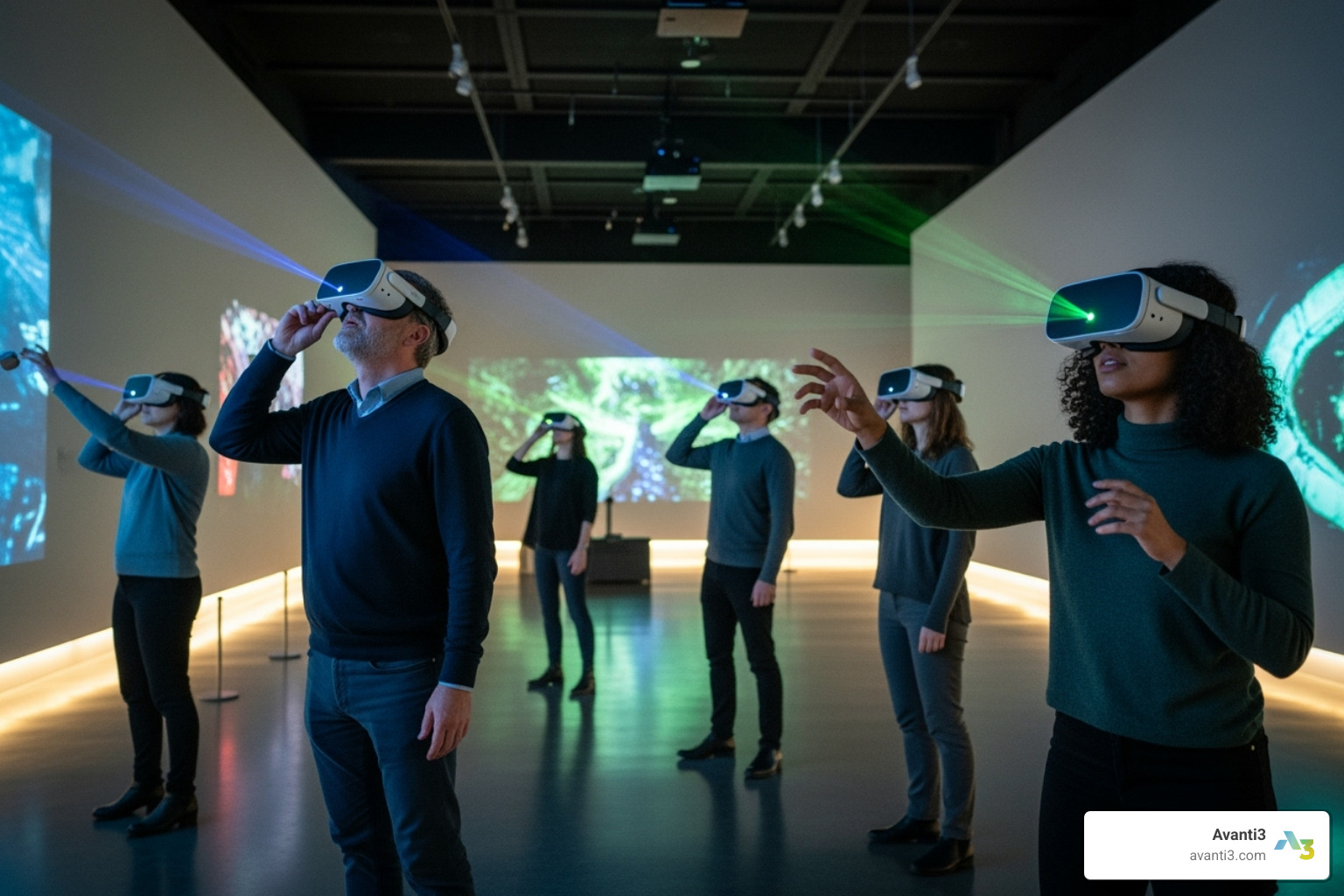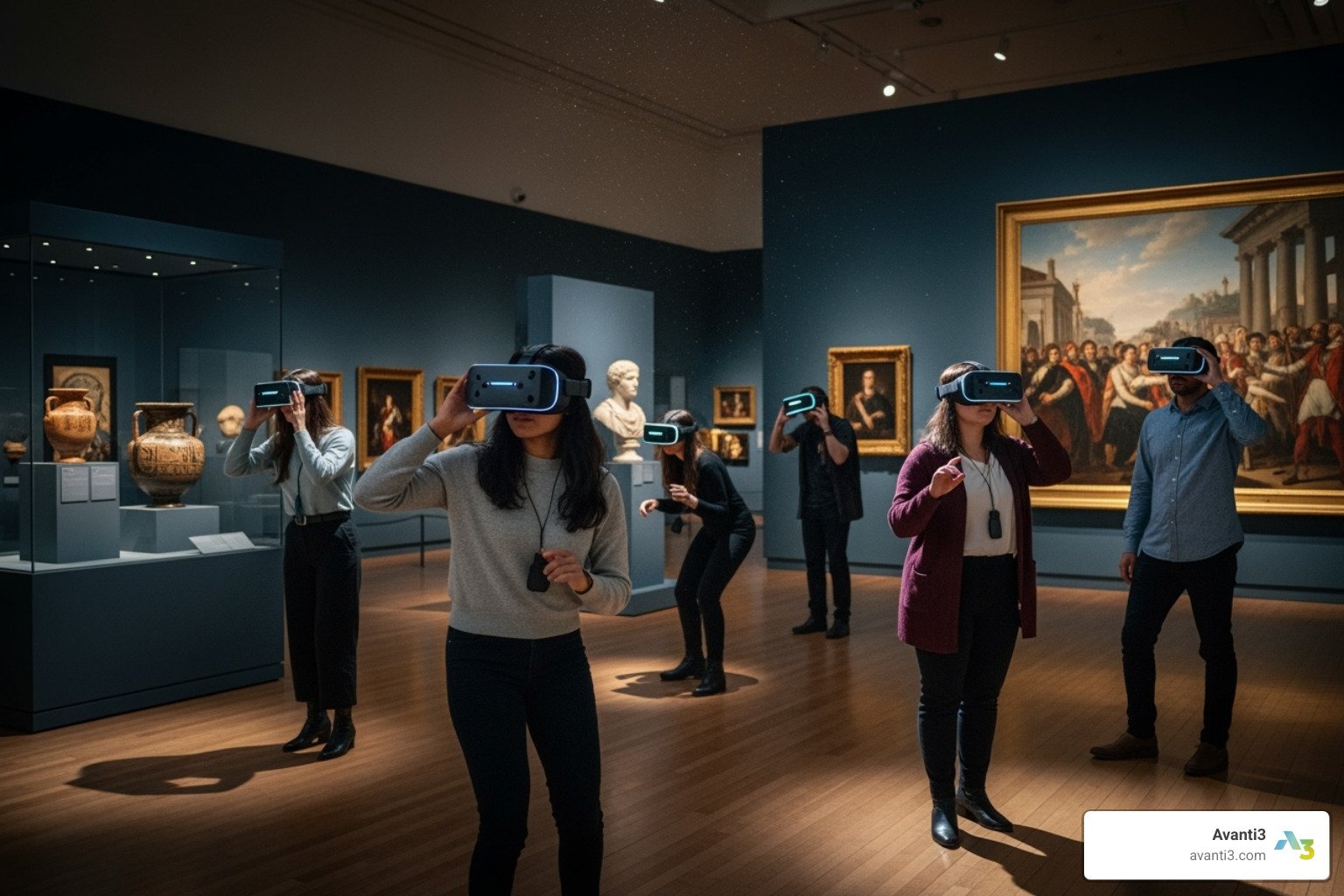Virtual reality technology and museum exhibit: 2025 Future
A New Dimension for Cultural Heritage
Virtual reality technology and museum exhibit experiences are changing how we connect with art, history, and culture. Museums worldwide are using VR to transport visitors through time, allow close examination of priceless artifacts, and create immersive storytelling experiences that were impossible just a few years ago.
Key ways VR improves museum exhibits:
- Accessibility – Virtual tours make collections available to global audiences and visitors with mobility challenges
- Preservation – Digital recreations protect fragile artifacts while allowing detailed interaction
- Context – VR places objects in their original settings, showing true scale and historical environments
- Engagement – Interactive experiences increase visitor satisfaction and encourage return visits
- Education – Multi-sensory learning creates deeper emotional connections with cultural heritage
From the Louvre’s “Mona Lisa: Beyond the Glass” experience to the Natural History Museum’s collaboration with David Attenborough, leading institutions are proving that VR doesn’t replace traditional exhibits – it improves them. Studies show VR improves visitor satisfaction and attracts younger demographics who might not otherwise engage with museums.
The technology allows museums to showcase collections held in storage, recreate historical sites that no longer exist, and offer experiences that transcend physical limitations. Whether it’s exploring Van Gogh’s creative process at the Musée d’Orsay or swimming with ancient sea creatures at the Natural History Museum, VR is opening new possibilities for cultural storytelling.
Virtual reality technology and museum exhibit terms to learn:
The Immersive Revolution: How Virtual Reality Technology and Museum Exhibits are Merging

The integration of virtual reality technology and museum exhibit design marks a pivotal moment in how we engage with cultural heritage. We are moving beyond static displays to dynamic, interactive worlds that bring history and art to life. VR offers museums an exceptional tool to breathe life into their collections, providing a unique and captivating experience that transports visitors to new dimensions.
Redefining the Visitor Experience
Imagine stepping into Van Gogh’s “The Night Cafe” or exploring the intricate details of a dinosaur skeleton with its skin and muscles restored. This is the magic of virtual reality technology and museum exhibit integration. It’s not just about seeing; it’s about experiencing.
- Contextual Learning: VR places artifacts in their original historical settings. The British Museum, for example, used VR to let visitors walk through a Bronze Age settlement, fostering a deeper understanding of the past.
- Gamification: Museums can use VR games to make learning interactive and fun, especially for younger audiences.
- Accessibility: VR removes physical barriers, allowing people with mobility issues or those living far away to explore world-class collections from home.
- Global Reach: With an estimated 90% of museum collections in storage, VR can open up these hidden treasures for a global audience.
Pioneering VR in the Museum World
Leading museums globally have acceptd virtual reality technology and museum exhibit integration. The Louvre’s ‘Mona Lisa: Beyond the Glass’ experience allows visitors to get closer to the masterpiece than ever before, while the ‘Horizon of Khufu’ project offers a stunning virtual tour of the Great Pyramid of Giza. The Natural History Museum’s Hold the World lets you interact with rare specimens alongside Sir David Attenborough. These examples showcase the transformative power of VR in cultural exploration.
Benefits and Challenges of VR Adoption
While the potential of virtual reality technology and museum exhibit integration is immense, there are practical considerations.
Benefits:
- Increased Engagement: VR experiences are highly engaging and can attract new, tech-savvy audiences.
- New Revenue Streams: Museums can create new income sources through paid VR experiences or virtual merchandise.
- Digital Preservation: VR allows for the creation of permanent digital archives of temporary exhibitions.
Challenges:
- Cost: High-quality VR development and hardware can be expensive.
- Technical Needs: Requires specialized skills in 3D modeling and programming.
- Logistics: Managing visitor flow, equipment maintenance, and hygiene for on-site VR is crucial.
- User Experience: Ensuring comfort and avoiding motion sickness is key to a positive experience.
VR vs. AR: Choosing the Right Immersive Tool
While VR creates fully immersive digital worlds, Augmented Reality (AR) overlays digital information onto the real world. Both are powerful tools for museums.
| Feature | Virtual Reality (VR) | Augmented Reality (AR) |
|---|---|---|
| Definition | A fully immersive, computer-generated environment. | Overlays digital information onto the real world. |
| Immersion | High: Replaces the user’s real-world surroundings. | Partial: Improves the user’s current environment. |
| Hardware | Requires a dedicated headset (e.g., Oculus Quest, HTC Vive). | Can be used on smartphones, tablets, or AR glasses. |
| Use Case | Virtual tours of historical sites, interactive art installations. | Displaying extra information about an artifact, animating a dinosaur skeleton. |
For more information on how museums are using this technology, you can explore resources from the American Alliance of Museums.
Practical Considerations for Implementation
Setting up virtual reality technology and museum exhibit experiences requires careful attention to the practical details that make or break the visitor experience. While the technology itself might be impressive, the real magic happens when everything works smoothly behind the scenes.
- Hygiene: With shared headsets, robust cleaning protocols are essential. Use disinfectants between each use and consider disposable face masks to ensure visitor safety and comfort.
- Comfort: Choose headsets that are adjustable and comfortable for a wide range of users, including those who wear glasses. A comfortable fit prevents distraction and improves immersion.
- Motion Sickness: To prevent “cybersickness,” design VR content with smooth movements and avoid sudden, jarring transitions. Keeping experiences to a manageable length (5-15 minutes) is also recommended.
- Staff Training: Your team is the front line. Ensure they are well-trained to operate the equipment, assist visitors, and troubleshoot minor technical issues. Their confidence translates directly to the visitor’s experience.
- Space and Safety: Designate a clear, safe area for VR experiences. Use physical or virtual boundaries to prevent accidents and ensure users can move freely without risk.
Successful virtual reality technology and museum exhibit implementation depends on mastering these practical elements alongside the exciting technology.
Looking Ahead: The Evolving Role of Virtual Reality Technology and Museum Exhibits
The integration of virtual reality technology and museum exhibit design is just getting started. The future promises even more profound ways to preserve, share, and experience cultural heritage.
Digital Preservation and Global Access
VR technology allows museums to create detailed digital archives of their collections and even temporary exhibitions. This means a special installation can be preserved and experienced by a global audience long after it has physically closed. This democratization of culture breaks down barriers of geography and physical ability, making art and history accessible to anyone, anywhere. A student in a small town can virtually walk through the Louvre, and a person with mobility challenges can explore ancient ruins without limitation.
The Future is Interactive and Community-Driven
The next wave of innovation will be driven by even more interactive and social experiences. Imagine AI-powered guides that tailor tours to your interests, or haptic feedback that lets you “feel” the texture of a sculpture. Social VR will allow you to explore these digital spaces with friends and family from across the globe.
This evolution also opens up new opportunities for the creator economy. Museums can now engage with their audience in new ways, offering digital collectibles (NFTs) of famous artworks or exclusive access to virtual events. These are not just novelties; they are powerful tools for building a dedicated community of supporters and creating sustainable revenue streams. By embracing Web3 technologies, cultural institutions can fund preservation efforts, research, and new exhibitions, ensuring our shared heritage thrives in the digital age.






